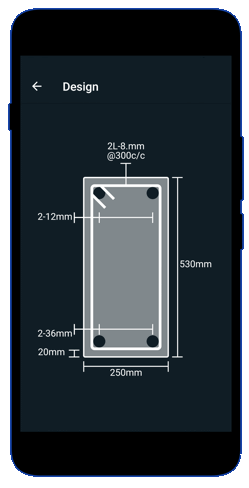Beams play a crucial role in the structural stability and integrity of buildings and infrastructure. As fundamental components of any construction project, beams are responsible for transferring loads and supporting the weight of the structure above them. In order to ensure their strength, safety, and durability, it is imperative to adhere to established design standards and codes.
In the context of India, the Indian Standard code IS 456:2000 provides guidelines and provisions for the design of reinforced concrete structures, including beams. Following the IS codal provisions is of utmost significance as it not only ensures compliance with national standards but also guarantees the structural soundness and reliability of the beams.
You can check these post to know more about beams and its types.
This blog will explore the step-by-step design process of a SRB section, as per the guidelines outlined in IS 456:2000. By understanding and implementing these design steps, engineers and designers can create beams that meet the necessary criteria for strength, deflection, and durability, thus contributing to the overall stability and safety of the structures they support.
Steps to design a singly reinforced beam section
The different steps involved in design of a SRB as per IS:456 2000 are given below:
Trial Section
Assume breadth of the section such that b ≥ Breadth of the wall. Commonly used values are 150, 200, 230, 250, 300, 350,380, 400mm.
Assume depth of the section such that, D = L/10 to L/16. Commonly used values are 300, 380,450, 530, 600, 680, 750, 840, 900 mm.
Assume effective cover d’ between 40mm to 70mm as per the environmental condition.
Effective depth $$d = (D -d’) mm $$
Assume Breadth of Support as bs
Analysis of the slab
In this step, compute the moment of the beam.
Consider the various loads due to
- Slab from Left side: The equivalent uniformly distributed load transferred from slab on left side of the beam is denoted as ws1.
- Slab from Left side: The load transferred from the slab on right side is denoted as ws2.
- Masonry wall: ww = $\gamma$ tw Hw ;where, tw = thickness in m, Hw = height in m. $\gamma$ = unit weight of masonry (for RC wall $\gamma = 25$).
- Self weight: Self load refers to the weight of the structure itself, including the weight of the material used in construction and any fixtures or furnishings., $$w_s = 25 (D – D_f) b_w $$
- Dead Load: To refer to the permanent weight of a structure and its parts.
- Live load: The temporary or movable loads that a structure or building is prone to during its use.
- Total load : Calculate the total load and factored load as (1.5 * Total load)
Design moment For flanged section calculate flange width bf. Check whether the neutral axis lies inside the flange or outside the flange.
$$ M_{ur})_{x_u = D_f} = 0.36 f_{ck} b_f D_f (d – 0.42 D_f) $$
$$ M_{u.max} < (M_{ur})_{x_u = D_f}$$
N.A. lies inside the flange.
This case normally governs in the case of slab- beam construction
Calculate main steel
Depending on the type of beam cal. area of steel at mid -span, For rectangular section, Required:
$$
A_{s t}=\frac{0.5 f_{c k}}{f_y}\left[1-\sqrt{1-\frac{4.6 M_u}{f_{c k} b d^2}}\right] \times b \times d
$$
For flanged section with $$x_u <= D_f $$
$$ Required,
A_{s t}=\frac{0.5 f_{c k}}{f_y}\left[1-\sqrt{1-\frac{4.6 M_u}{f_{c k} b d^2}}\right] \times b \times d
$$
The continuous beams at supports are generally, required to be designed as DRB and rarely as a SRB section.
Check this post to follow the different design check required, as per IS 456: 2000.
Conclusions
In conclusion, the efficient design of singly reinforced beam demands following a step-by-step approach according to IS 456: 2000. The design process include several key steps, including determining the load capacity, calculating the effective span, and determining the depth of the beam and the reinforcement of beam.
In this post you have learned the following points:
- Importance of Beams: Beams are crucial for providing support and stability to buildings and infrastructure, as they transfer loads and bear the weight of the structure above them.
- Adhering to IS 456:2000: Following the Indian Standard code for R.C.C. design is imp. to ensure the integrity and safety of beams, as it provides guidelines specific to the Indian context.
- Contribution to Safety: Properly designed beams leads to the overall safety, and durabilityof structures, and ensuring the well being of users.
Beam design
- RCC Beam Design is a free app for designing reinforced concrete beams as per Indian Standards.
- RCC Design and detailing could be performed by Limit State Method specified in IS456:2000
- Option to save the design projects in local storage.
- Detailed calculation steps presented for verification and validation.

Also, check this post to know the design procedure of doubly reinforced beam section
This article was crafted by a group of experts at eigenplus to ensure it adheres to our strict quality standards. The individuals who contributed to this article are:
Author


